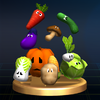Vegetable
- This article is about the items from Super Mario Bros. 2. For Princess Peach's and Princess Daisy's down special move in the Super Smash Bros. series, see Vegetable (move).
- "Sprout" redirects here. For the character from Yoshi's Crafted World, see Sprout (character).
Template:Item-infobox Vegetables[1][2][3][4][5] (also shortened veggies[4][5]) are objects that can pulled out of the ground and thrown at enemies to damage or defeat them. They are first introduced in Yume Kōjō: Doki Doki Panic and the Mario game, Super Mario Bros. 2. The most commonly recurring vegetable is the turnip, which has made several appearances throughout the Mario franchise following Super Mario Bros. 2.
History
Super Mario series
Super Mario Bros. 2
Vegetables are first found in Subcon in the game Super Mario Bros. 2. They can be plucked with the B button and thrown at enemies. Unripened vegetables[1] (also called Sprouts[2][3], Tiny Vegetables[4] or Small Vegetables[5]) are smaller than the ripe ones but are just as effective when throwing. Almost all the red grass in the game is a vegetable when plucked. Vegetables can appear as turnips, onions, beets, radishes, and other root vegetables.
Wart is said to hate vegetables in the game's story; he needs to be force-fed six vegetables to be beaten. The pale vegetable in the bottom right side of the picture to the left is only seen when thrown out of Wart's Dream Machine.
BS Super Mario USA
Vegetables return in the game BS Super Mario USA. They are used in the same manner in the predecessor. The game introduces giant vegetables that cannot be picked up. Instead, these giant plants only appear as spells cast by a character who appears on the screen as a card.
Super Mario Advance
Vegetables return in Super Mario Advance, working the same way they did originally. This version of the game also features large turnips called Giant Vegetables[5], which take longer to pull out. They work just like their normal-sized counterparts, but can hit more enemies, due to their bigger size.
The Super Mario Bros. Super Show!
Vegetables appear in some episodes of The Super Mario Bros. Super Show!. Mario and Luigi use them in various episodes to defeat their enemies, the Koopa Pack and King Koopa like in Super Mario Bros. 2. The vegetable-throwing sound from Super Mario Bros. 2 is also commonly used in the show even for things such as the firing of a Bullet Bill and the throwing of a fireball.
Mario vs. Wario
Vegetables were given a minor appearance in one of the Mario vs. Wario comics. The first page of this comic showed Mario recalling "playing in the garden" with Wario when the two were friends; during this scene, several vegetables are present and Wario even picks one up Super Mario Bros. 2-style. Wario, too, remembers this garden scene on the next page, although his memory is a little less fair: he recalls Mario asking for help in the garden and taking a row of turnips as his own, leaving Wario to tackle the Piranha Plants on his own.
Super Smash Bros. series
In Super Smash Bros. Brawl and Super Smash Bros. Ultimate, the Summit stage features vegetables from Ice Climber that act as food. When they are eaten, they make a special, different sound effect from the other foods, the same sound effect used in the original game when Popo or Nana collect a vegetable.
Official profiles
Super Mario Bros. 2
- Wii Virtual Console manual: "Pull out a lot of these and something cool might happen..."
Super Smash Bros. Brawl trophy
Names in other languages
Vegetable
| Language | Name | Meaning | Notes |
|---|---|---|---|
| Japanese | 野菜[6] Yasai |
Vegetable | |
| German | Gemüse[?] | Vegetable | |
| Italian | Verdura[?] | Vegetable | |
| Swedish | Grönsak[?] | Vegetable |
Unripened vegetable
| Language | Name | Meaning | Notes |
|---|---|---|---|
| Japanese | はずれ野菜[6] Hazure Yasai |
Failed Vegetable | |
| Italian | Germoglio[?] | Sprout |
References
- ^ a b Super Mario Bros. 2 NES instruction booklet, page 18.
- ^ a b Nintendo Power Volume 1, page 10.
- ^ a b Super Mario All-Stars Player's Guide. Page 88.
- ^ a b c Super Mario All-Stars instruction booklet, page 20.
- ^ a b c d Super Mario Advance North American instruction booklet, page 26.
- ^ a b Yume Kōjō: Doki Doki Panic instruction booklet, page 24.
